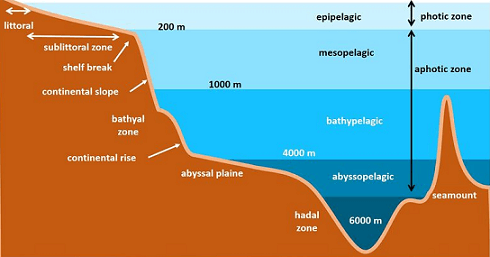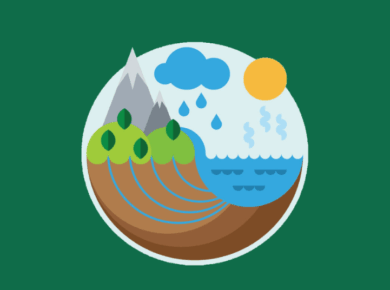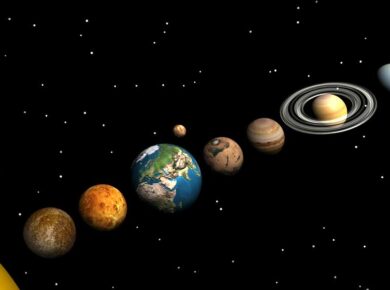Hydrosphere – Ocean Floor Division
Ocean Floor Division
Continental Self
- Basically, the seaward extension of the continent from the shoreline to the continental edge approx. 200 m deep
- Continental shelf is thus a shallow platform, whose width varies greatly from a few miles in North Pacific off the continent of North America to over 100 miles off Northwest Europe
- In some places, where the coasts are extremely mountainous, such as at Rocky Mountains, the continental shelf may be entirely absent
- The angle of slope is also variable with most common of 1 in 500 & is normally the least, where the continental shelf is widest

- Continental shelves may be formed by submersion of part of continent due to increase in sea level or by wave erosion or conversely by off-shore deposition.
- Continental shelves shallowness enables sunlight to penetrate through the water, which encourages the growth of minute plants & other microscopic organisms such as planktons, on which millions of fishes & polyps survive. The continental shelves are therefore the richest fishing grounds in the world.
Continental Slope
- At the southern edge of continental self, seaward slope immediately becomes steep & gradient to about 1 in 20 with average depth 200 – 3000 m.
- Most of the canyons & trenches are observed in this region
Continental Rise
- Beyond the continental slope is continental rise, an area of gentle slope with angle varying from .5 – 1*
- With increasing depth, it virtually becomes flat & merges with abysmal plains
Abysmal Plains
- Where the continental rise end, deep sea plains begin covering 2/3rd of the ocean floor
- Average depth is of 3000 – 6000 m
- Flattest & smoothest surfaces of the world
Some important terms
Oceanic Deeps or Trenches
-
-
- Deepest part of the oceans
- Generally steep sided narrow basins, deeper then oceanic floors
- Occurs at the base of continental slopes & associated with active volcanos & strong earthquakes
- Hence, Contrary to our expectations, most of the deepest trenches are not located in the midst of the oceans but found close to the continents
- Deepest trench of the world > Marina trench (11 km) of Guam islands (Pacific Ocean)
- Hence we can see that ocean trenches are greater in magnitude than the highest mountains on the land
-
There are thousands of hills on ocean floors which are submerged under ocean water. A submarine peak rising > 1000 m above the ocean floor is called a seamount. Flat topped seamounts are known as Guyots (Volcanic in origin)
Gorge vs Canyon
-
-
- Gorge / Trench > Narrow & steep side valley formed by down cutting action of river
- Canyon > Magnified form of Gorge. Ex. Grand canyon of river colarado (US) > Largest one
-
Difference between Straits & Isthmus
Straits
|
Isthmus
|
Oceanic Deposits on Ocean Floor
| Muds |
|
| Oozes |
|
| Clays |
|
For more updates, explore the Geography . Feel free to share your thoughts and comments.
If you’re passionate about building a successful blogging website, check out this helpful guide at Coding Tag – How to Start a Successful Blog. It offers practical steps and expert tips to kickstart your blogging journey!









2 comments
thankyou very much to share the knowledge.
Hii Team,
Hope you guys doing great !!
Overall your content, structure and presentation are awesome !! If you prepare notes on current affairs and publish practice question paper.. no doubt you can easily compete with the other highly reputed on-line upsc coaching giants..
Please look at the differences between strait and Isthmus.. You may get confused while presenting the content..
Thanks,
Srini